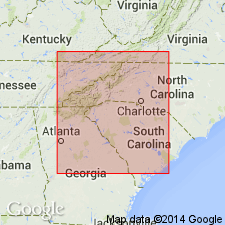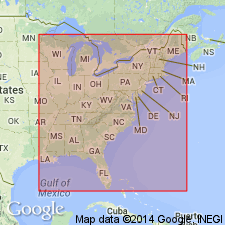
- Usage in publication:
-
- Blacksburg schist*
- Modifications:
-
- Original reference
- Dominant lithology:
-
- Schist
- AAPG geologic province:
-
- Piedmont-Blue Ridge province
Summary:
Pg. 29, 73. Blacksburg schist. A formation, 800 to 1,000 feet thick, which varies from a fine-grained graywacke (an impure variety of sandstone) to sericite schist. Overlies quartzite, conglomerate, and schist [Kings Mountain quartzite] and underlies Gaffney marble. Age is Cambrian (probably Early). [See also A. Keith, USGS Gaffney-Kings Mountain folio, no. 222, 1931.]
[Named from development in Blacksburg, Cherokee Co., northwestern SC. Extends into Gaffney quadrangle, Lincoln and Cleveland Cos., southern NC.]
Source: US geologic names lexicon (USGS Bull. 896, p. 207).

- Usage in publication:
-
- Blacksburg Schist*
- Modifications:
-
- Age modified
- AAPG geologic province:
-
- Piedmont-Blue Ridge province
Summary:
Pg. 89 (geol. time scale), 109. Blacksburg Schist. Age changed from Cambrian(?) --to-- Ordovician to Mississippian. (Authors follow revised time scale of Holmes, 1959, Edinburgh Geol. Soc. Trans., v. 17, pt. 3, p. 183-216.)
Source: Publication; Changes in stratigraphic nomenclature, 1964 (USGS Bull. 1224-A, p. A16).

- Usage in publication:
-
- Blacksburg Schist
- Modifications:
-
- Age modified
- Overview
- AAPG geologic province:
-
- Piedmont-Blue Ridge province
Summary:
Age of Blacksburg Schist shown as Late Proterozoic. Blacksburg is among list of formal rock-stratigraphic units within the Kings Mountain belt that have been avoided or used with discretion because of various problems. Quartzite which Keith and Sterrett (1931) mapped as Kings Mountain quartzite are found within rocks they mapped as Blacksburg schist as well as within those they mapped as Battleground schist and Gaffney Marble crops out at two stratigraphic levels within the Blacksburg.
Source: GNU records (USGS DDS-6; Reston GNULEX).

- Usage in publication:
-
- Blacksburg Formation*
- Modifications:
-
- Revised
- Redescribed
- Dominant lithology:
-
- Quartzite
- Marble
- Amphibolite
- Schist
- AAPG geologic province:
-
- Piedmont-Blue Ridge province
Summary:
Blacksburg Schist is redefined as Blacksburg Formation and revised to include quartzite units previously mapped as Kings Mountain Quartzite, marble, amphibolite, and calcsilicate rock interlayered with sericite schist and phyllite. Formation is fault-bounded and upper and lower contacts are unknown. Gaffney Marble is reduced to Gaffney Marble Member and assigned to Blacksburg. Informal Dixon Branch marble member may be the Gaffney repeated by faulting. Age is assumed to be Late Proterozoic(?).
Source: GNU records (USGS DDS-6; Reston GNULEX).

- Usage in publication:
-
- Blacksburg Formation*
- Modifications:
-
- Age modified
- AAPG geologic province:
-
- Piedmont-Blue Ridge province
Summary:
Age of Blacksburg Formation is Late Proterozoic to Early Cambrian as shown in table 12 of report.
Source: GNU records (USGS DDS-6; Reston GNULEX).
For more information, please contact Nancy Stamm, Geologic Names Committee Secretary.
Asterisk (*) indicates published by U.S. Geological Survey authors.
"No current usage" (†) implies that a name has been abandoned or has fallen into disuse. Former usage and, if known, replacement name given in parentheses ( ).
Slash (/) indicates name conflicts with nomenclatural guidelines (CSN, 1933; ACSN, 1961, 1970; NACSN, 1983, 2005, 2021). May be explained within brackets ([ ]).

